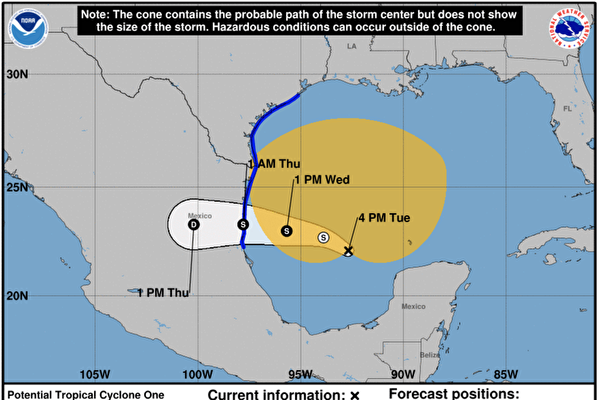This week, some areas in southeast Texas have issued a potential tropical cyclone alert, prompting Texas Governor Greg Abbott to activate the state’s emergency response resources before the potential storm arrives.
In a press release on Monday, Abbott announced that he had directed the Texas Division of Emergency Management (TDEM) to prepare for the impact of the storm on coastal communities along the Gulf of Mexico.
“Texas is prepared to deploy all necessary resources and assistance to help support the communities in southeast Texas facing a potential destructive tropical storm attack,” Abbott said in a statement.
Texas’s TDEM emergency system resources include aerial, ground, and water search and rescue teams, mobilization of utility workgroups, as well as air, water, and wastewater monitoring.
The National Hurricane Center’s warning forecast indicates that this tropical cyclone could become the first hurricane of the season and will be named Tropical Storm Alberto.
“The National Hurricane Center is issuing alerts about Potential Tropical Cyclone One located southwest of the Gulf of Mexico,” the agency warned on Tuesday morning, adding that there is an 80% chance of formation within the next 48 hours.
As the name suggests, the system has not yet developed into a tropical storm, but it is expected to begin developing along the Texas coast and northeastern Mexico on Tuesday night.
“The warning applies to the Texas coast from south of O’Connor Port to the mouth of the Rio Grande River” and “the northeast coast of Mexico south of the Rio Grande River to south of Altamira Port,” the National Hurricane Center said.
With a radius extending outward up to 290 miles, sustained winds approaching 40 miles per hour, with stronger gusts, are expected to intensify within the next 36 hours.
Heavy rainfall is also anticipated in the region, potentially leading to significant flash flooding and urban flooding.
The National Hurricane Center stated, “The system is quite large, and rainfall, coastal flooding, and strong winds may occur far away from the center of the storm along the coasts of Texas and northeastern Mexico.”
Abbott urged community members to remain vigilant in emergencies or extreme situations and to follow the instructions of local officials.
“I urge Texans to stay tuned to the weather and listen to the guidance of local officials to ensure the safety of themselves and their families. Remember: turn around, don’t drown,” he said.
The National Weather Service continues to monitor and track this storm.
Last month, forecasters from the National Oceanic and Atmospheric Administration (NOAA) projected that compared to the relatively mild hurricane season in 2023, there is an 85% higher probability of hurricanes in the Atlantic basin this year. This year’s hurricane season began on June 1 and will last until the end of November.
NOAA estimates that there will be 17 to 25 named storms with winds reaching or exceeding 39 miles per hour during this hurricane season. Up to 13 storms are expected to develop into hurricanes with winds of 74 miles per hour or higher, including 4 to 7 major hurricanes with winds exceeding 111 miles per hour.
The agency calculates its hurricane season predictions based on several factors, including near-record warm temperatures in the Atlantic, the La Niña phenomenon in the Pacific, and lower wind shear in the Atlantic.
Forecasters stated, “Meanwhile, the abundant oceanic heat in the tropical Atlantic and Caribbean Sea provides more energy for storm development.”
They also use artificial intelligence (AI) technology to assist in their predictions.
NOAA Administrator Rick Spinrad said in a statement on May 23, “Artificial intelligence language translation and new prediction cones for inland wind threats are just two examples of proactive measures our agency is taking to fulfill our mission of saving lives and protecting property.”

